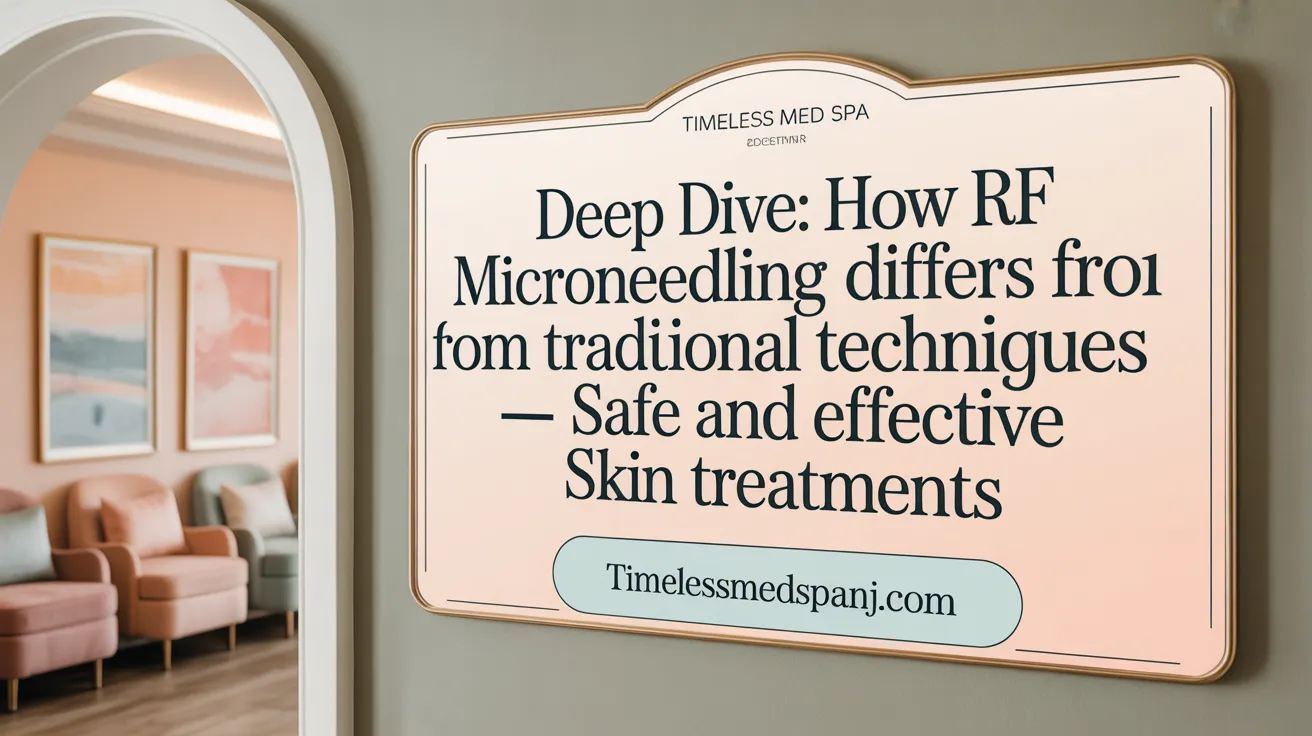Introduction to Microneedling Treatments
Microneedling is a popular, minimally invasive skincare treatment designed to rejuvenate the skin through collagen and elastin stimulation. Two primary techniques dominate this arena: traditional microneedling and the more recent RF (radiofrequency) microneedling. Each method offers unique advantages and is suited to different skin concerns and goals. This article provides an in-depth comparison of RF microneedling versus traditional microneedling, highlighting their key benefits, procedural differences, effectiveness, and considerations to help readers make an informed choice.
Fundamental Differences Between RF Microneedling and Traditional Microneedling

What is the difference between RF microneedling and traditional microneedling?
RF microneedling uniquely combines the mechanical action of microneedling with the application of radiofrequency (RF) energy. This dual approach not only creates tiny punctures in the skin but also delivers heat deep into the dermis. The thermal energy stimulates more robust collagen and elastin production, resulting in tighter, more rejuvenated skin.
Traditional microneedling, on the other hand, relies solely on fine needles to create controlled micro-injuries. These micro-wounds trigger the body's natural healing process, which boosts collagen and elastin without any added heat or energy. Its primary focus is on improving surface skin issues like fine lines, scars, and pore size.
Technology and Devices Used
| Treatment Type | Device Involved | Main Mechanism | Depth of Penetration | Additional Benefits |
|---|---|---|---|---|
| Microneedling | Dermapen or similar devices | Micro-injuries to stimulate healing | Up to 3.5 mm | Improved skin texture and tone |
| RF Microneedling | Specialized devices like Exceed™ or Morpheus8 | Micro-injuries + RF deep heat | Up to 8 mm | Skin tightening, deeper scars, and wrinkles |
How each treatment stimulates the skin
Traditional microneedling prompts collagen growth through minor skin injuries that activate natural healing. This process gradually improves skin texture, reduces scars, and diminishes fine lines.
RF microneedling amplifies this effect by adding heat energy, which causes immediate collagen fiber contraction and enhances long-term collagen remodeling, offering significant skin tightening and scar reduction.
Procedure overview and safety
Both treatments are minimally invasive and performed by trained professionals. Traditional microneedling usually involves 3-6 sessions spaced weeks apart, with minor redness and swelling that clears within a few days. It is suitable for superficial skin concerns and has minimal downtime.
RF microneedling typically requires fewer sessions—often 3-4—because of its ability to stimulate deeper tissue. Downtime may be slightly longer but remains minimal, with most patients returning to normal activities quickly.
Both treatments are considered safe across most skin types when performed correctly, with RF microneedling offering a more dramatic result due to its deeper, thermal effects.
Key Benefits and Effectiveness of RF Microneedling Compared to Traditional Microneedling

What are the benefits of RF microneedling compared to traditional microneedling?
RF microneedling combines the mechanical stimulation of tiny needles creating micro-injuries with the application of radiofrequency (RF) energy. This combination leads to deeper collagen remodeling and skin tightening, offering a significant improvement over traditional microneedling that only creates superficial micro-injuries.
One major advantage is the ability to target deeper skin layers safely because RF energy heats the dermis without damaging the surface, resulting in more pronounced lifting and tightening effects. The treatment can be easily customized through adjustable RF intensity and needle depth, allowing practitioners to focus on specific concerns like deep scars or severe laxity.
Compared to traditional microneedling, RF microneedling tends to require fewer sessions—about 3 to 4—because of its enhanced collagen-stimulating capabilities. It also offers more dramatic and faster results, often visible after just a few sessions.
Another benefit is the safety profile; RF microneedling is suitable for most skin types, including darker tones, and minimizes the risk of pigmentation issues common with laser treatments. This treatment modality produces less surface trauma and shorter recovery times, with most patients experiencing only 1 to 2 days of mild redness.
In summary, RF microneedling provides deeper, more effective skin rejuvenation with longer-lasting outcomes, making it an excellent choice for treating moderate to severe skin aging signs, deep scars, and skin laxity.
Procedural and Technological Differences Shaping Outcomes

How do the procedures, technology, and outcomes differ between RF microneedling and traditional microneedling?
Traditional microneedling involves the use of fine needles to create tiny micro-injuries on the surface of the skin. This process stimulates the body's natural wound-healing response, resulting in increased production of collagen and elastin that helps improve skin texture, tone, and reduces fine lines, scars, and enlarged pores. The procedure typically stimulates superficial skin layers, reaching depths of up to about 3.5 mm, and usually requires multiple sessions spaced several weeks apart.
In contrast, RF microneedling combines the micro-injury process with the delivery of radiofrequency (RF) energy into deeper skin layers. This is achieved through specialized insulated needles that can target specific depths depending on the treatment area and skin condition. The RF energy heats the dermal tissue, inducing collagen remodeling and tightening the skin more effectively than traditional microneedling alone.
The thermal effect from RF enhances the procedure's ability to address skin laxity, deep wrinkles, and scars. The results tend to be more dramatic and longer-lasting—typically between 12 to 18 months—due to the deeper stimulation and the enhanced collagen production.
Devices such as Morpheus8 and EXION exemplify advanced RF microneedling technology. Morpheus8 integrates deep RF energy delivery with micro-punctures, penetrating even further into the dermis for significant improvements. The EXION device is designed to deliver RF at depths up to 8 mm, providing a comprehensive rejuvenation with improved skin tightening.
Safety profiles are comparable when treatments are performed by trained professionals. Both methods have minimal adverse effects, but RF microneedling usually results in shorter downtime, less discomfort, and quicker recovery due to its controlled thermal injury process.
In summary, RF microneedling surpasses traditional methods by combining micro-needling with thermal energy, achieving deeper collagen stimulation, more noticeable tightening, and longer-lasting results. It is particularly effective for extensive skin concerns like laxity, deep scars, and significant signs of aging, offering a substantial technological advancement over traditional microneedling.
Choosing the Right Treatment: Factors to Consider

What factors should be considered when choosing between RF microneedling and traditional microneedling?
Selecting the appropriate skin rejuvenation treatment depends on several factors related to your skin concerns, desired results, and personal circumstances.
RF microneedling combines radiofrequency energy with micro-punctures, allowing for deeper collagen stimulation, skin tightening, and more dramatic improvements. It is particularly effective for more severe issues like deep scars, significant wrinkles, and skin laxity. RF microneedling generally requires fewer sessions—around 3 to 4—producing results that can last up to six months or more.
Traditional microneedling, however, involves creating micro-wounds on the skin surface with fine needles. It is ideal for milder concerns such as fine lines, superficial scars, enlarged pores, and sun damage. This method tends to have less discomfort, quicker recovery, and often needs more sessions—about 4 to 6—to achieve noticeable results.
Another key consideration is customization. RF microneedling offers adjustable treatment depth and RF energy levels, making it versatile for different skin types and concerns. Patients with deeper skin issues or seeking significant tightening often benefit more from RF microneedling, as it targets deeper skin layers without damaging the surface.
Cost and downtime also influence the decision. RF treatments are typically more expensive due to their complexity and potency but offer faster and more long-lasting results. They may also involve slightly longer recovery periods, but generally, both procedures involve minimal downtime — redness and swelling typically subside within a few days.
Finally, individual skin type matters. Both treatments are considered safe for most skin tones when performed by trained professionals, but RF microneedling's ability to stimulate deeper collagen production makes it suitable for a wider range of concerns and skin types, especially those with pronounced aging signs.
In summary, the choice hinges on understanding your specific skin issues, how aggressive the treatment should be, your budget, and your ability to tolerate recovery times. Consulting with a qualified dermatologist can help tailor the best approach tailored to your needs.
Treatment Effectiveness for Acne Scars and Cost Considerations

How effective are RF microneedling and traditional microneedling for treating acne scars?
RF microneedling usually offers superior results in treating acne scars compared to traditional microneedling. Its ability to deliver radiofrequency energy deep into the skin stimulates collagen, elastin, and hyaluronic acid production across multiple layers, which is essential for scar remodeling.
This deep heating effect enhances skin tightening and helps break down scar tissue, improving the overall appearance and texture of scars. It is especially effective for challenging scars like ice pick or deep atrophic scars.
Traditional microneedling also encourages collagen growth by creating micro-injuries, but it has limited penetration and does not incorporate heat energy. Therefore, its results are generally more moderate, requiring more sessions to see significant change.
For more serious scars, RF microneedling’s ability to customize treatment depth and deliver thermal damage leads to quicker, more noticeable improvements that tend to last longer.
What are the typical costs associated with RF microneedling compared to traditional microneedling?
Cost differences between RF and traditional microneedling are notable, mainly due to the technological complexity of RF devices. For instance, at a reputable clinic, four sessions of traditional microneedling may cost around $1,625, while RF microneedling can reach about $3,100 for the same number of treatments.
When additional treatments like Platelet-Rich Plasma (PRP) are included, costs increase further. PRP with traditional microneedling might be about $2,925, whereas for RF microneedling, this could escalate to $4,400.
The higher expense of RF is justified by its advanced energy delivery system, deeper skin penetration, and faster, more pronounced results. Patients should consider these costs against the potential for more effective and lasting scar improvement.
How long do the results last, and what is their overall value?
Results from RF microneedling tend to last longer—up to 6 to 12 months—thanks to its deeper collagen stimulation and skin tightening effects.
Traditional microneedling results generally last around 3 to 5 months, making RF treatments more cost-effective over time because fewer sessions are needed for sustained benefits.
The broader improvements in skin firmness, texture, and scar appearance make RF microneedling a valuable investment for those with deeper or more stubborn scars.
Both treatments are safe when performed by trained professionals, but RF microneedling’s enhanced efficacy and longevity often justify the higher upfront costs for many patients seeking noticeable, durable skin improvement.
Final Thoughts on RF and Traditional Microneedling
Both RF microneedling and traditional microneedling offer effective, minimally invasive options for skin rejuvenation tailored to differing needs and severity of skin concerns. Traditional microneedling remains a valuable choice for mild to moderate surface-level conditions with a favorable cost and shorter recovery time. Conversely, RF microneedling leverages advanced technology, delivering deeper collagen remodeling, superior skin tightening, and longer-lasting results, particularly for more severe wrinkles, scars, and skin laxity. Ultimately, the decision hinges on individual skin goals, budget, downtime preferences, and the level of transformation desired. Consulting with a qualified practitioner can ensure a personalized treatment plan that maximizes benefits while aligning with each patient’s unique requirements.
References
- What's the Difference Between RF Microneedling and Regular ...
- Morpheus8 RF microneedling vs. Traditional Microneedling
- RF Microneedling vs. Traditional Microneedling in Bellevue, WA
- Comparing RF Microneedling with the EXION and Traditional ...
- Traditional vs. Virtue RF Microneedling: Which is Best?
- Is RF Microneedling Better Than Traditional Microneedling?
- RF Microneedling vs. Microneedling: The Key Differences That Will ...
- RF Microneedling vs Microneedling | What's The Difference?
- Traditional Microneedling vs. RF Microneedling: What's the ...
